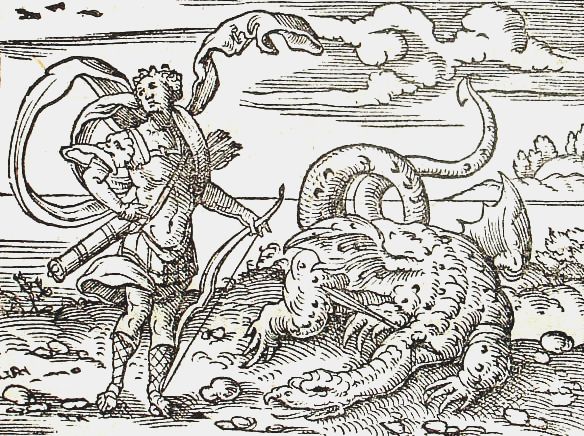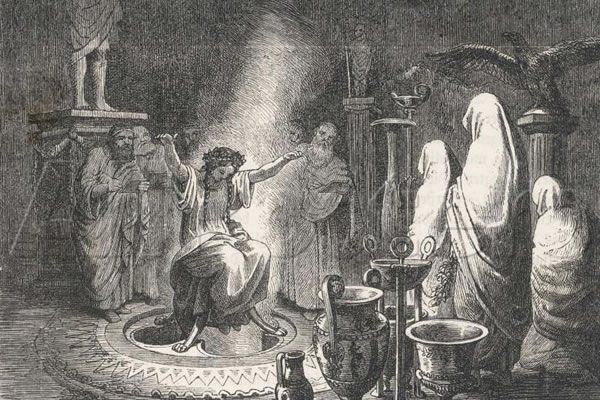Python
In Greek mythology, Python (also called Pytho) was the serpent, sometimes represented as a medieval-style dragon, living at the center of the Earth, believed by the ancient Greeks to be at Delphi. Later Christian and occult traditions viewed Python as a powerful demon connected with divination and prophecy.
Mythology
Much of the mythology surrounding Python has been described as an allegory for the dispersal of the fogs and clouds of vapor that arise from ponds and marshes (Python) by the rays of the Sun (the arrows of Apollo).
Python presided at the Delphic oracle, which existed in the cult center for its mother, Gaia, "Earth," Pytho being the place name that was substituted for the earlier Krisa. Greeks considered the site to be the center of the Earth, represented by a stone, the omphalos or navel, which Python guarded.
Python became the chthonic enemy of the later Olympian deity Apollo, who slew it and took over Python's former home and oracle. These were the most famous and revered in the ancient Greek and Roman worlds. Like many monsters, Python was known as Gaia's son and prophesied as Gaia's son. In turn, Apollo had to eliminate him before he could establish a temple in Delphi.
Origin stories
There are various versions of Python's birth and death at the hands of Apollo. In the Homeric Hymn to Apollo, now thought to have been composed in 522 BCE when the archaic period in Greek history was giving way to the Classical period, a small detail is provided regarding Apollo's combat with the serpent, in some sections identified as the deadly drakaina, or her parent. The god searching for a place to establish his shrine, reached Delphi and saw the Python, who was a bane to the people. He slew the serpent and declared himself as the owner of the Oracular shrine.
The version related by Hyginus holds that when Zeus lay with the goddess Leto, and she became pregnant with Artemis and Apollo, Hera was jealous and sent Python to pursue Leto throughout the lands, to prevent her from giving birth to the twin gods. Thus, when Apollo was born and was four days old he pursued Python, making his way straight for Mount Parnassus where the serpent dwelled and chased it to the oracle of Gaia at Delphi; there he dared to penetrate the sacred precinct and kill it with his arrows beside the rock cleft where the priestess sat on her tripod.
Robert Graves, who habitually read into primitive myths a retelling of archaic political and social turmoil, saw in this the capture by Hellenes of a pre-Hellenic shrine. "To placate local opinion at Delphi," he wrote in The Greek Myths, "regular funeral games were instituted in honor of the dead hero Python, and her priestess was retained in office."
Oracle at Delphi
The priestess of the oracle at the Temple of Apollo at Delphi became known as the Pythia, after the place-name Pytho, which Greeks explained as named after the rotting (πύθειν) of the slain serpent's corpse in the strength of Hyperion (day) or Helios (the sun). Her title was also historically glossed in English as the Pythoness.
The Pythia was established at the latest in the 8th century BC, (though some estimates date the shrine to as early as 1400 BC), and was widely credited for her prophecies uttered under divine possession (enthusiasmos) by Apollo. The Pythian priestess emerged pre-eminent by the end of the 7th century BC and continued to be consulted until the late 4th century AD. During this period, the Delphic Oracle was the most prestigious and authoritative oracle among the Greeks, and she was among the most powerful women of the classical world. The oracle is one of the best-documented religious institutions of the classical Greeks.
Pythia sat on top of a tall gilded tripod that stood above the opening. Originally, Pythia was a virgin, young girl, but after Echecrates of Thessaly kidnapped and violated a young and beautiful Pythia in the late 3rd century BC, a woman older than fifty years old was chosen, who dressed and wore jewelry to resemble a young maiden girl.
Conflation in other religions
Erwin Rohde wrote that the Python was an earth spirit, who was conquered by Apollo, and buried under the omphalos and that it is a case of one god setting up his temple on the grave of another. In this sense, in the Egyptian religion, Python had a nearly identical function to Apophis, the snake god who embodied chaos and was chased across the sky each night by Ra.
Karl Kerenyi notes that the older tales mentioned two dragons who were perhaps intentionally conflated. A female dragon named Delphyne (Δελφύνη; cf. δελφύς, "womb"), and a male serpent Typhon (Τυφῶν; from τύφειν, "to smoke"), the adversary of Zeus in the Titanomachy, who the narrators confused with Python. Python was the good daemon (ἀγαθὸς δαίμων) of the temple as it appears in Minoan religion, but she was represented as a dragon, as often happens in Northern European folklore as well as in the East.
In Christianity
The imagery of the snake being defeated by a hero was adopted by later Christians as St. George trampling the Dragon. This represented the power of Jesus Christ (the Sun / Apollo / Ra) defeating Satan (darkness / Python / Apophis).
In his book on demonology, Daemonologie (1597), King James equated the Witch of Endor with the oracle of Pythia. Further expounding on this belief, many modern Christians believe the spirit of Python or Pytho is one of the most dangerous spiritual adversaries that a person can encounter.
In the Bible
In the New Testament, Acts 16:16-18 tells the story of a girl who was possessed by the spirit of Python. It was exorcised from the girl by Paul using the name of Jesus Christ. Although in most translations, the spirit is not named, the Greeks believed Python was the primary spirit responsible for prophecy and divination, therefore, some translations now name the spirit as Python.
16 And it came to pass, as we went to prayer, a certain damsel possessed with a spirit of divination met us, which brought her masters much gain by soothsaying:
17 The same followed Paul and us, and cried, saying, These men are the servants of the most high God, which shew unto us the way of salvation.
18 And this did she many days. But Paul, being grieved, turned and said to the spirit, I command thee in the name of Jesus Christ to come out of her. And he came out the same hour.
Occult beliefs
According to Heinrich Cornelius Agrippa, in his Three Books of Occult Philosophy, Python is the name of the demon who rules over the second degree of diabolical spirits in the Hierarchy of Hell. This degree is known as the "deceitful spirits."
English occultist Francis Barrett, in his book The Magus, expands upon Agrippa's list and places Python as ruler over the Spirits of Lies. He gives the demon's stone as emerald with an astrological correspondence to the Starry Heaven.

